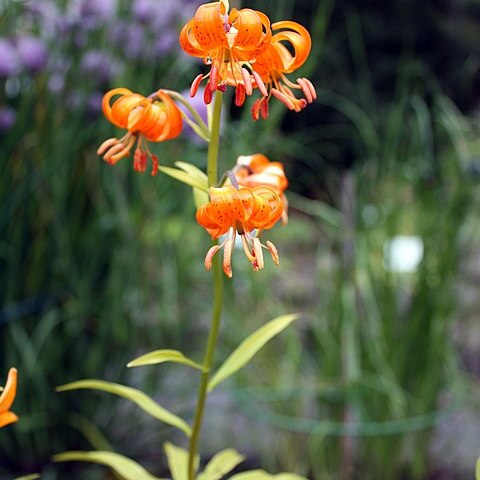Bulb subglobose, 2--2.5 cm in diam.; scales white, oblong-lanceolate, 1--2 cm × 3--4 mm, articulate. Stem 30--75(--100) cm, smooth, rarely slightly papillose proximally. Leaves usually in a whorl of 7--12(--20) plus a few scattered, lanceolate-oblong, lanceolate, or oblanceolate, 5--12(--17) × 1.5--4 cm, glabrous, rarely slightly scabrous at margin, apex acute to acuminate. Flowers solitary or 2--4(--10) in an umbel or raceme, nodding, rarely to ascending, not fragrant. Tepals strongly revolute, apricot-colored to bright red, with black spots, lanceolate, (3--)3.5--4(--4.5) cm × 5--10 mm, rather thick, apex papillose; nectaries not papillose. Stamens shorter than tepals; filaments glabrous; anthers ca. 1 cm. Ovary ca. 1 cm. Style sometimes thickened toward apex. Capsule obovoid, 1.5--2 cm, 3-ribbed. Fl. Jul--Aug. 2 n = 24*.
More
A bulb plant. The bulb is 2-2.5 cm across. The scales are white. The stem is 30-75 cm high. It is smooth. The leaves are usually in a ring of 7-12. They are sword shaped and 5-12 cm long by 1.5-4 cm wide. The flowers can be single or 2-4 in a group. They are nodding but do not have a scent. They are orange to red with black spots. The fruit is a capsule. It is oval and 1.5-2 cm across. It has 3 ribs.
Damp woods and meadows, occasionally to the sub-alpine zone, in N. and C. Japan. Forests, subalpine grasslands, limestone and serpentine areas.
More
It is a temperate plant. It grows in forest and subalpine grassland on limestone in N China.

